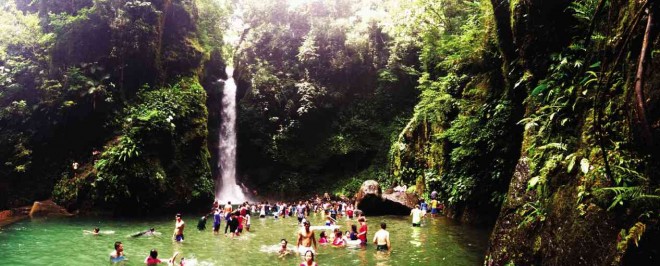
THE DITUMABO waterfalls in San Luis town in Aurora province has been drawing an average of 4,000 excursionists on weekends due to continuous gushes of cool water. TONETTE OREJAS/INQUIRER CENTRAL LUZON
SAN LUIS, Aurora—A set of waterfalls known only to loggers and vine gatherers in the 1970s has been luring tourists to this town.
The Ditumabo waterfalls in Barangay (village) Ditumabo here hosted around 4,000 excursionists on May 2 and 3 alone. The figures are double the average of 1,000 visitors on Saturdays and Sundays every April and May, said a town employee who has been documenting visitor arrivals here since May 1 when the town government started managing the place.
An ordinary day draws about 500 people, according to a logbook.
Tour guide Lolita Tangson, 60, said the place was made popular through Facebook.
Many people were seen frequenting the place in 2010, said Tangson. The town’s hydro power plant may have made the place accessible, she said.
The construction of the facility began in 2005 while operation started in 2011. Trekkers developed a 1.2-kilometer trail just beside the plant’s big pipeline. The trail near the mini dam stands on a pipeline covered with concrete.
Another trail is via the sides or middle reaches of a river. This route, however, is for the more physically able since boulders and stones, covered by slippery moss, filled the river.
Whatever trail you take, the climb is cool as trees provide shade most of the time.
The safer trail is taken by senior citizens. “I helped an 82-year-old woman reach the top,” Tangson said, to emphasize that the route was made for easy, slowly rising climb.
On the way down, we met two women in their 70s hiking up without the aid of walking canes.
Most trekkers skip the first waterfall, heading straight to the more spectacular “Mother Fall.” “It got that name because it’s the biggest waterfall in this part of the mountain,” said Tangson.
Mother Fall, said to be more than 140 feet high, feeds the pool below. The gushes are continuous, casting their shower over a 20-meter area. Water is fresh and very cold, an antidote to the sweltering heat.
Two sets of boulders provide swimmers platforms to warm their bodies. The walls on this part of the mountain are filled with all sorts of plants.
Visitors pay P30 in ecotourism development fee that is announced at the entrance. The local government issues a government accountable form for the payments.
Because food and drinks are banned at the waterfalls, the local government designated three sites where these could be bought, including souvenir items, all from local traders.
The falls have 47 accredited tour guides, 15 of them women, each serving one or two tours daily. Rates go from P200 to P300. Tangson said grateful tourists give tips.
Like Tangson, Irene Gomez, 34, spends her income on food and other needs of her three children. “The waterfalls are helping us support our families,” Tangson said.
Aside from the Ditumabo waterfalls, another reason for visiting the place is the Sabutan crafts and the vast tracts of green-to-gold rice fields.
Several visitors said the Ditumabo waterfalls are first in their itinerary, the springboard to other destinations in Aurora: crowded beaches in Barangay Sabang in Baler; more exclusive getaways in Sitio Diguisit in Barangay Zabali, also in Baler; and more scenic spots far north up to Casiguran town.